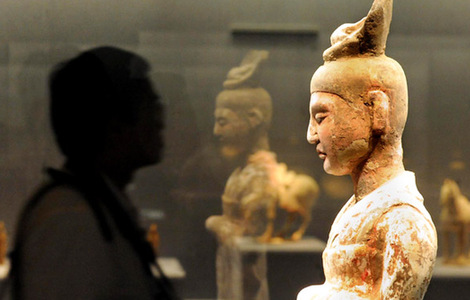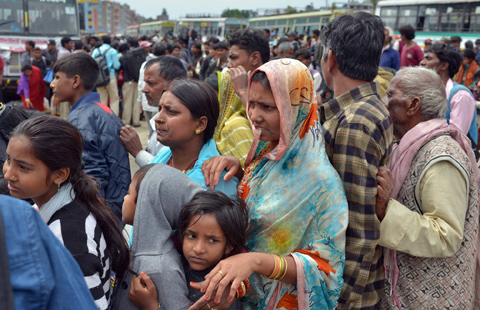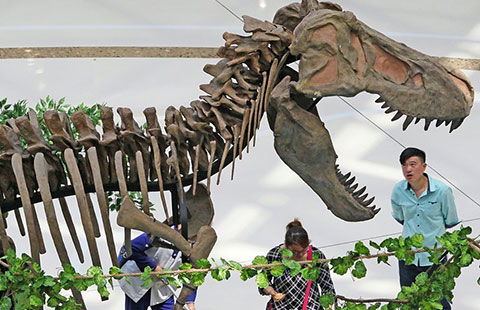The 'nightmare' everyone saw coming
Updated: 2015-05-01 10:01
By Christopher Davis(China Daily USA)
|
||||||||
Useful prediction
For a prediction to be useful, Sleep said, it has to be in a relatively short time and has to specify the magnitude and location. "A prediction that there's going to be a magnitude-8 earthquake this year somewhere in the world is probably true, but not particularly useful," he said. "Everybody in the world can't camp outside for a year."
"Basically everybody's equally good at predicting earthquakes, which means that nobody's good at it at all," he said.
Sleep said prognosticators could do considerably better than chance and still not be of any service. "If you said the chance that one coming in 2015 rather than being one in 75 was one in 30 of getting this earthquake in Nepal, you've doubled the risk but you haven't really changed how people react to it."
The vast interface of India and Asia is what scientists call a "belt" of seismic activity. Everywhere along it India is trying to work its way under China. So everywhere along it, earthquakes are inevitable.
"If there hasn't been one in quite a while we can expect that to be the place where the next earthquake happens," said van der Pluijm. "It's called the 'seismic gap theory'. When there has not been an earthquake in a certain place while we know that the process that generates earthquakes is taking place, we can say that is a more likely place for the next event to take place."
Large earthquakes in similar areas over the past decades are also a dead giveaway. But nearby earthquakes can also throw off a prediction. In the case of Nepal, Sleep said, "you go back in the record and they're occurring on average every 75 years but not precisely every 75 years. A large earthquake nearby Nepal might change the recurrence interval because we've changed the stresses of the Earth."
And nearby earthquakes can also add stress to the one in focus, hurrying the event along. "A small earthquake doesn't relieve the stresses a lot but it can be a foreshock, where it's adding stresses very nearby the earthquake," Sleep said. "A magnitude 5 releases about a 30th of the energy of a magnitude 6, and so on. So this earthquake released over 20 times more energy than the earthquake did in Haiti."
How can that amount of energy be described in non-earthquake terms? "People have used H bombs, but it's so large that nothing is particularly helpful," Sleep said. "This earthquake was about the size of the 1906 San Francisco earthquake, but the energy released there was spread over a larger distance. Again both earthquakes were not particularly good for structures."
James Jackson, a University of Cambridge-based seismologist who was among the scientists in Kathmandu the week before the earthquake, told The Associated Press, "The construction is appalling in Kathmandu." But he acknowledged that it made sense in a country where nearly a quarter of all people live below the poverty line and build what they can with what they have.
Other priorities
"If you live in Kathmandu Valley you have other priorities, daily threats and daily nasty things happen to you in terms of air quality, water quality, pollution, traffic and just poverty," he said. "But it doesn't mean the earthquakes go away."
Masonry buildings that are not reinforced are highly vulnerable to collapse in earthquakes and when they do collapse, they kill a lot of people, Sleep said. "It's difficult enough in the US to get people to refit buildings and in an area that's impoverished it is even more difficult," he said. "I'm not an engineer, but I do know how not to build a building."
In a book entitled Earthquake Hazard, Risk, and Disasters members from the National Society for Earthquake Technology noted Nepal's lax building codes had only increased the destruction that might be caused by an earthquake. They wrote:
"No system exists for controlling the professional standards of engineers/designers through reference to professional qualifications/membership, peer review processes, or by legal means. Further, the owner builders, who follow the advice of local craftsmen and mason leaders, build a significant proportion of the buildings in Nepal.
Neither the owner builder nor the crafts persons are aware of the possible disastrous consequences of an imminent earthquake. They do not have adequate access to information related to safer building practices and incorporation of simple earthquake-resisting features at nominal extra costs.
Even building construction projects funded by national and multilateral agencies generally do not spell out adequate requirements related to seismic safety in their terms of reference to their consultants."
Van der Pluijm thinks people should be aware that predicting earthquakes is a two-sided coin: "Even though we can't give the exact date and time, we can tell you the things to expect, and landslides is one of the things that were predicted once we had an earthquake for that area. And of course the tragedy is the landslides are making it very difficult to have rescue efforts underway."
The same is true with buildings, he said. He used the analogy of putting a building on top of a skateboard and then kicking the skateboard suddenly. If the building is not well built, it topples over.
"That's what happens with these buildings," he said. "There's a lot of aggressive, quick motion of the ground and buildings when they're not engineered to withstand ground motion have no chance. And people live in buildings and this is why the injuries happen."
Sleep noted that in the Haiti earthquake, the US and Canadian embassies, which were built to earthquake code, went virtually unscathed. Haiti, like Nepal, is basically denuded of wood so there isn't the material to build wood-frame and plaster structures that cause fewer injuries when they're shaken into collapse.
"It's not a problem of ignorance, it's a problem of resources," Susan Hough of the United States Geological Society said. "People are building houses to live in with the resources that they have. They can't afford rebar and engineering."
Sleep said that earthquake codes do a lot of good. "There's no such thing as something being totally earthquake proof, but levels of shaking increase very rapidly as you go to stronger and stronger shaking, so any improvement you make buys you a lot of good," he said.
Van der Pluijm said that the issue really is humans interacting with geology. "We have to come to grips as a society on how to respond to the impact of these events. We predict for you what will happen, we can tell you the ground motions, we can tell you what buildings to build. They're very expensive, of course and these are very poor countries," he said.
"It sounds very preachy to say this because I realize these people have daily suffering that exceeds ours even on a regular basis," he continued. "That is the scary part: these buildings have no chance. They are not built to withstand anything. That is why probably unfortunately we'll hear about a lot more death and suffering as the days go by and they discover more villages that were impacted and destroyed by this process."
"These are incredibly damaging events, these earthquakes. They are huge events."
Continents on the move are now tracked by GPS and their longer paths can be measured by analyzing the magnetic anomalies at the ridge edges, getting spreading rates and then laying it over the geometry of a sphere. The Nepal event moved the Himalayas about 2 meters higher, but erosion and landslides are already working to reclaim that gain in height.
The reason the Himalayas are there is exactly because of earthquakes like this," said van der Pluijm. "And there will be more coming."
Through telemetry, all of the data is fed in real time into data bases in laboratories all over the world and will be analyzed. "It's no longer the days when you had to write to monasteries and they'd send you seismograph readings over a several-year period," Sleep said.
This event will be added to the data base and be "just one more thing out of many," Sleep said, "and we're not going to able to predict earthquakes on what they learned from this one, unless someone gets awful more lucky than I think they will."
Contact the writer at chrisdavis@chinadailyusa.com

 Across America over the week (from April 24 to 30)
Across America over the week (from April 24 to 30)
 Across Canada (May 1)
Across Canada (May 1)
 China's top 10 GDP provinces in Q1
China's top 10 GDP provinces in Q1
 Photos capture marvelous landscapes of China
Photos capture marvelous landscapes of China
 Mass exodus from Kathmandu
Mass exodus from Kathmandu
 Running on water: a nearly impossible feat
Running on water: a nearly impossible feat
 Ten photos you don't wanna miss - April 30
Ten photos you don't wanna miss - April 30
 'Comfort women' survivor attends protest of Japan PM
'Comfort women' survivor attends protest of Japan PM
Most Viewed
Editor's Picks

|

|

|

|

|

|
Today's Top News
Abe betrays history's conscience
The 'nightmare' everyone saw coming
Vancouver property developer identified as Chinese fugitive: report
Freddie Gray tried to hurt himself in police van
China trainmakers seek control of Bombardier's rail unit
New rich set sights on tech, media and telecom sectors
US rapped for stance on Japan
Obama, Abe talk much about China
US Weekly

|

|






